#which is influenced by wahabism
Explore tagged Tumblr posts
Text
reading about Salafi history is so interesting
what do you mean you were kinda cool (not fully, but definitely some based ideas) but then one dude got a little too into wahabism and so created a whole knew version of salafism which went against original salafism what
what do you mean you were originally a political movement against western imperialism and the authoritarian-esque hiearchies within sufism and spent most of your time preaching for rational discussions and scientific innovation but that was stopped cause OF ONE FRICKING DUDE
idk it's just so funny that the salafi movement's entire point was "lets do stuff from the past" which is textbook conservative but then the stuff in the past was "science is amazing and i love reframing my worldview with every new discovery" which is textbook progressive.
(I do think they're wrong btw, i just think they had a few good ideas sprinkled amongst the weird stuff)
#to clarify#i don't agree with a lot of the salafi beliefs (even from the original political movement)#a big example being i believe god is omnipresent#and i think spirituality should be a massive driver within faith and religion#but i can't completely disagree with their desire to overthrow power structures or make science compatible with religion#this is of course not talking about modern day salafism#which is influenced by wahabism#plus i think the stuff they consider “religious innovation” or bidah is bs cause lets be real i'd much rather trust a practice from#100 years after Islam originated to represent Islam better than i will a practice suddenly discovered in the 1860s#islam#muslim#muslims#islampost#islamdaily#islamic#islamicpost#islamblr#muslimblr
15 notes
·
View notes
Text
Random Vedic Astrology Observations
Adele who is Ardra Rising and Lana Del Rey who is Ardra Sun both have a Paradise tattoo on the side of their hand
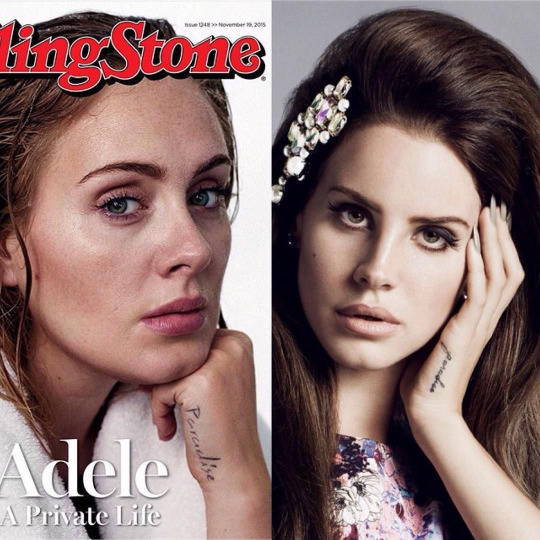
This is very interesting symbolism because Ardra nakshatra is preceded by Mrigashira nak which follows the fall from Paradise.
2. Pisces natives 🤝🏼 sculptures







L to R
Rihanna- Revati Stellium (including Moon & Rising)
Ava Gardner- Ketu in (1 degree Pisces) Purvabhadrapada
Bella Hadid- Ketu in UBP
Rosie Huntington Whiteley- UBP Mercury & Rahu, Mars in Purvabhadrapada (0 degrees Pisces) and Jupiter in Revati atmakaraka
Jin- UBP Moon
Isabelle Adjani- Revati Rising
Salma Hayek- UBP Moon
3. Jyeshtas really love jewellery


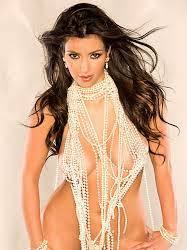

Vidya Balan- Mercury in Jyeshta (atmakaraka)
Rekha- Jyeshta Rising
Kim Kardashian- Jyeshta Rising
Nicki Minaj- Jyeshta Sun
4. I'd earlier made an observation about how Mars influenced men tend to go after older women and I thought I'd add a few more examples to that list!!
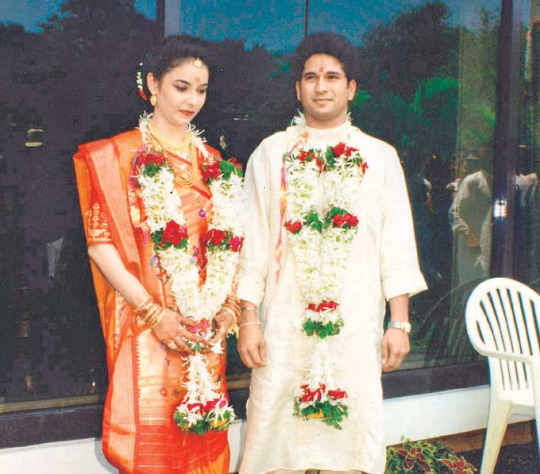
Sachin Tendulkar & Anjali Tendulkar have an age gap of 6 years and their wedding was hugely controversial when it took place in the 90s. Sachin was only 22 when he got married.
Sachin has Mars in Dhanishta atmakaraka and Moon in Purvashada amatyakaraka
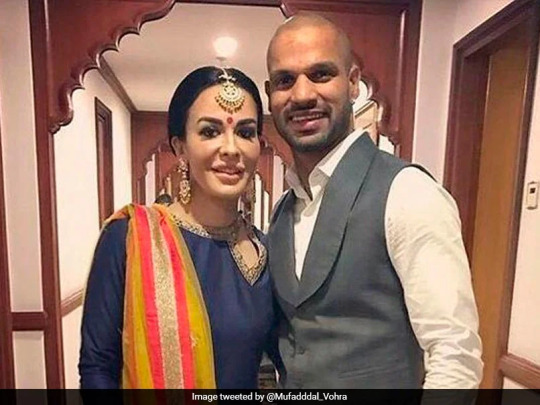
Shikhar Dhawan and his ex-wife Ayesha Mukerji have an age gap of 10 years.
Shikhar is Dhanishta Rising, Mars in Chitra atmakaraka with Purvaphalguni Moon

Arjun Kapoor and Malaika Arora have an age gap of 12 years
He is most likely Chitra Rising
He also has Venus (amatyakaraka) conjunct Rahu in Bharani
I know that Bharani is Venus ruled but Bharani is the confluence of Mars & Venus energies and is ruled by the Mars ruled Aries and is another nakshatra that commonly appears in the charts of men drawn to older women

Aditya Pancholi is 6 years younger than his wife Zarina Wahab
He has Sun in Purva Ashadha, Venus amatyakaraka (in Jyeshta) Jupiter in Bharani and Rahu in Mrigashira

Karan Singh Grover is 6 years younger than Bipasha Basu
He has Moon in Dhanishta, Mars (amatyakaraka) conjunct Saturn (atmakaraka) in Chitra with Ketu in Purva Ashada
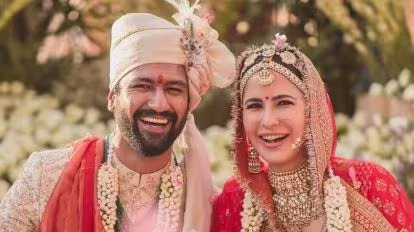
Vicky Kaushal is 5 years younger than Katrina Kaif
He has Venus in Mrigashira, Mars in Dhanishta, Jupiter (amatyakaraka) in Bharani, Ketu in Purva phalguni

Farhan Akhtar and his first wife, Adhuna Akhtar have an age gap of 7 years.
Farhan has Sun (atmakaraka) conjunct Mercury (amatyakaraka) in Purva Ashada and Saturn conjunct Ketu in Mrigashira
5.


idk if im crazy but i think these 2 women have similar features 😭😭
Zhou Xun is Chitra Sun, Anuradha Moon, Swati Mercury, Chitra Venus & Mars
Ning Ning is Chitra Sun, Bharani Moon, Swati Venus and Ketu in Anuradha
6. Rihanna has a tattoo of Goddess Isis on her chest
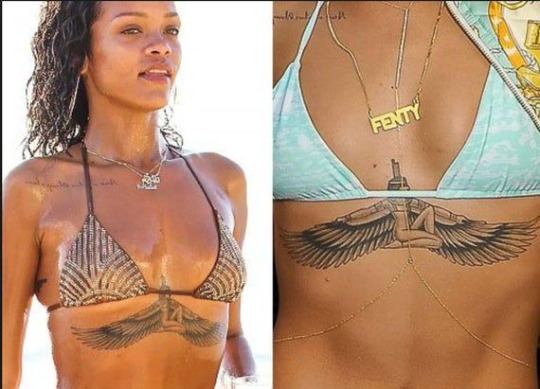
Rihanna is Revati Moon and Goddess Isis had powers like love, healing, fertility, protection, wisdom and magic. By virtue of her magical knowledge, she was said to be "more clever than a million gods". Revati nakshatra natives are endowed with divine spiritual wisdom and the deity of Revati, Pushan is the Sun-god in the form of Divine Guide and Nourisher, who helps us to find the right path and leads us to the right solutions.
Revati represents wisdom, empathy, unconditional love, fertility, growth, prosperity & spirituality.
7. Harry Houdini was a Hungarian-American escape artist, illusionist, and stunt performer, noted for his escape acts.
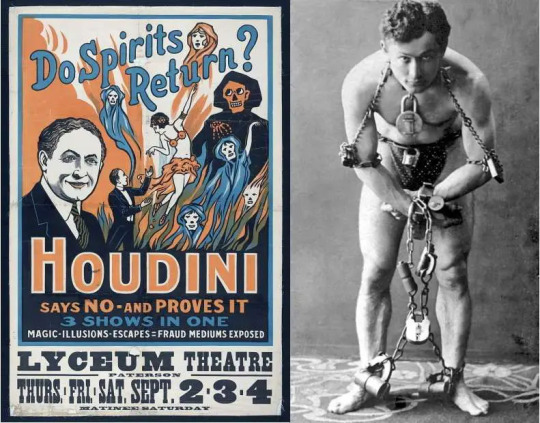
He has UBP Sun, Mrigashira Moon, Venus in Revati (exalted) and Ketu in Swati with Shravana Rising
Swati is connected to Maya or illusion so it makes sense as to why someone who has Ketu placed there would become notorious for hoodwinking the public.
Mrigashira nakshatra involves HEAVY themes of running away, escape and being trapped AND finding a way out. If you look at the mythology, its about Brahma's favourite daughter who takes the form of a deer to leave the heavens and run away to the earth to escape her father's sexual advances towards her.
Pisces rashi is almost always present in the charts of magicians or people who have some kind of illusory appeal on the public. Most mega successful celebrities have prominent Pisces placements, most supremely talented actors and singers do. The ability to put yourself out there yet remain completely mysterious and keep people under a veil is a uniquely Piscean trait.
Obviously with that Shravana Asc, he was basically born for this job. Moon dominant people are ADEPT at manipulation and making black seem like white or vice versa.
Dua Lipa recently released a song titled Houdini and she's Punarvasu Moon which I think is another nakshatra that is good at casting illusions.
#sidereal astrology#astrology notes#vedic astro notes#astrology observations#vedic astrology#nakshatras#astro observations#astro notes#astrology#astroblr
476 notes
·
View notes
Text
OK, so I made comments explaining a bit the situation in France, but I feel some exploration and deeper explanation would be good. For reference, here are the comments I made : "Hi, French here. I don't have numbers on zionism in France, but considering the rampant antisemitism in some parts of our Muslim population and apathy or even complicity from the culturally christian population, which drove Jews almost entirely out of the public education system, I very much expect high levels of zionism, if only out of self-preservation. And to be clear : teachers have been ringing the alarm since the 80s. They weren't listened to.
So, in short : France fucked up big time, we failed our values, and we failed our citizens, because apparently protecting Jews took too much effort and money, and it was less costly to just pretend nothing bad was happening rather than building a specifically tailored plan to fight against Arab antisemitism, as that particular variation was entirely unaffected by Holocaust Guilt. Add in the active parts of the traditional antisemitism and ... well ..." Now the point to deepen : The 80s were marked by the first forrays of political Islam in the French educative field. Before that, political Islam had already made local alliances with politicians looking for an easy election, but in the 80s they started to try to influence the French education system, too. See, in that period radical Muslim movements such as Wahabism/Salafism or the Muslim Brotherhood took more and more power, pushing more and more radical rethorics and trying to impose "purer", AKA more rigorists, takes on Islam. France already had a big Muslim population, so of course it was targeted too.
Moronic politicians who were still thinking of it as an alliance with an ecclesiastic, a bit like the local priest, failed to understand that THESE preachers were not the Catholic priests that had been beaten into submission by earlier Republican movements, and due to this failure of reading the room, the radicalist movements settled and took roots. This leads to my point : in the 80s, they started trying to influence lessons. With, of course, antisemitism. The first targets were the lessons on the Shoah, because of course. But they also attacked other lessons, such as the parts of the History module on world religions that talked about Judaism AND the part about Christianity. Then they attacked the science courses, pushing for Islamic creationism. Those movements also sent islam-flavoured creationist books to a great many school libraries.
There were death threats against teachers for teaching "the wrong thing". There was no support from the administration because they didn't want scandals. Teachers rang the alarm like mad, but were ignored. A book, a fucking entire book named "the Republic's lost territories" was published, exposing the problem, and was promptly vilified as a racist hit piece.
And of course, they attacked students not of their religion, though predominently the Jews. In that period of laissez-faire, Jews were almost entirely driven out of the public education system, and often out of neighborhood where they had lived for decades by then. Then sought refuge in closer communities, and even sent their kids to Catholic Schools rather than leaving them in the public system. Granted, Catholic Schools are banned from proselytizing in France, and most of these Jews were Sephardi, so less *immediatly and recently* traumatized by Christians, but still.
By then, on the national scene, most of our Left was nursing the comfortable idea that Muslims were inherently Left Wing, and thus Good, and due to this didn't want to do shit about it. And then 9/11.
Suddenly, people *woke up*. Suddenly, the piles of reports from teachers screaming about the issue for 20 fucking years were noticed. Suddenly, the teachers that had been browbeaten, insulted and called racists for daring to talk about sectarian violence, were not that easy to ignore. And that started a legislative process, though a flawed one. The end result : the wholesale ban of religious symbols in French schools. Stuff like the Islamic veil or the Yarmulke or cross pendants or sikh turbans or ... you get the idea.
This law is ... less than ideal, and I say that as a French teacher. But I still think it should stay there. Because it's the first and only line of legal defence we have to assert that, no, schools aren't religious territory. And gross as it is to say, I'd rather the nutjobs battle about wether or not the Islamic veil is allowed in classrooms than on wether or not the Shoah actually happened.
Because yes, the nutjobs are still there. It's the same people, with the same backers, under new organizations, pushing for the abolition of that law. The same people that preached the death of Samuel Patty. the same people that pushed another disenfranchised, mentally ill youth to kill Dominique Bernard, another teacher, on the 13th of October this year.
So yeah, we're at 40 years of that problem slowly building up, because we failed our values, because instead of fighting that issue when it came up, we let it fester, because abandoning the Jews was deemed acceptable for political gain.
And if we'd taken that problem seriously, if we'd actually acted to fight off the radicalists, we could have solved much of that issue by the 90s, maybe even before I was born in 92.
But our politicians didn't. And so, here we are.
Israeli polls find that most Israeli Jews define themselves as Zionist. American polls say most American Jews see Israel as integral to their identity. British polls show most British Jews support the right of Israel to exist, which is the definition of being Zionist (yep, it's not about specific policies, it's not about specific attitudes towards Palestinians, being Zionist is strictly about supporting Israel's right to exist, meaning supporting the Jewish right to have self determination in the Jewish ancestral homeland, a right that every other nation enjoys. Because this entails a return to ancestral lands, you can also define Zionism as the land back movement of Jews). I can't find a poll about French Jews and Zionism, but looking at a chart of countries from which Jews have been making aliyah (moving to Israel), when focusing on a single country, French Jews top it, which is presumably an indicator of a high level of Zionism.
As of late 2023, Israel accounts for 7.2 million Jews. The US for 6.3 million Jews. France for 440,000 Jews. Canada for 398,000 Jews. The UK for 312,000 Jews. These are the five biggest Jewish communities in the world today. Israel and the US alone account for 86% of world Jewry.
My point is, looking at all of this data together, there's no question that the overwhelming majority of Jews are Zionists. This isn't a fluke. It's a result of the fact that Judaism itself is inherently Zionist, a native religion sanctifying the bond between the People of Israel and their ancestral land.
If you find something that you can vilify, and using it you can easily target the majority of black people, you have an issue with black people. If you find something that you can vilify, and using it you can easily delegitimize the majority of women (for example, vilifying feminism, when most women are feminist, and portraying it as if it's inherently anti-men), you have an issue with women.
If you use "Zionist" as a slur, as a dirty word, as a way of discrediting Jews, as a way of silencing them, as a way of implying they're somehow inherently anti-anyone, if you are delegitimizning the majority of Jews just based on this term, if you have an issue with the overwhelming majority of Jews, you have an issue with Jews.
(for all of my updates and ask replies regarding Israel, click here)
438 notes
·
View notes
Text
Week 11: Digital Citizenship and Conflict: Social Media Governance

Hello guys welcome back! Have you ever thought about how social media influences the way we act online and how it deals with drama, especially harassment and cyberbullying? Let’s explore digital citizenship, social media governance, and how they relate to online harassment!
First of all, let’s talk about what is digital citizenship. Digital citizenship involves using technology responsibly, safely, and respectfully. It includes protecting private information online, reducing risks from cyber threats, and using information and media in a respectful, informed, and legal manner (Digital Citizenship: What it is & What it Includes | Learning.com 2023). While we live and interact online much like we do offline, we aren't always mindful of our online actions. Sometimes we act without considering the impact on our reputation, safety, and growth as digital citizens. Meanwhile, everything we do online shapes our digital world and identity. Social Media Governance refers to the guidelines, methods, and steps that social media platforms use to control and oversee how users behave and what they post on their platforms (Murthy 2024). The purpose of social media governance is to keep the internet a safe, respectful, and legal place to be while also protecting user rights and free speech.

Do you know that if you don’t use social media wisely will lead to harassment and cyberbullying? These are serious issues that affect many people online. Harassment involves repeated, unwanted behavior that makes someone feel intimidated or threatened. Cyberbullying is a type of harassment that happens specifically online. It can include spreading rumors, sending threatening messages, or publicly humiliating someone. Both can have devastating effects on victims, leading to anxiety, depression, and even suicidal thoughts. Based on my research, over 3000 cases is reported in Malaysia in 2023 (Rashidi 2024). MCMC also found that Facebook was the most common platform for cyberbullying, with 1,401 reports. WhatsApp came in second with 667, followed by Instagram with 388, TikTok with 258 and X with 159 and both adults and teenagers also reported being harassed within the past 12 months, up from 23% in 2022 to 33% in 2023 for adults, and 36% to 51% for teenagers (Wahab 2023). Social media platforms like Facebook, Twitter, and Instagram have their own rules to keep things in check. These rules are supposed to prevent stuff like cyberbullying, fake news, and hate speech. But let's be real—sometimes these platforms don't always get it right. They have to balance free speech with the need to protect users from harmful content.
One big part of social media governance is content moderation. This is where platforms use a mix of algorithms and human moderators to check what’s being posted (Content Moderation Justice and Fairness on Social Media: Comparisons Across Different Contexts and Platforms 2024). While AI can catch some bad stuff, it’s not perfect. Human moderators have the tough job of deciding what stays and what goes, which can be super stressful. One of the examples where conflicts often pop up is when misinformation and fake news, lead to misunderstandings and disputes. Users may share unverified information, which can cause disagreements over what is true (The Role of Social Media in Modern Conflicts n.d.)
Let’s talk about the legal framework for cyberbullying in Malaysia. In Malaysia, there is no existing legal provision specifically to tackle cyberbullying cases in Malaysia. Besides, we can also refer to Section 233 of the Communication and Multimedia Act 1998 which is Improper use of network services, which includes making any comment that is considered offensive, abusive, and intended to harass another person, if anyone is convicted, the offender could be fined of not more than RM50,000 or imprisonment for up to 1 year, or both (Iskandar 2023). Malaysia’s government should take cyberbullying seriously and come out with a legal law for cyberbullying.
So, what can we do as digital citizens? We can start by being mindful of what we post and how we interact with others. Think twice before sharing something controversial or unverified. Be respectful in your comments and conversations. And if you see something harmful, report it. Together, we can make social media a better place.
Reference
Content Moderation Justice and Fairness on Social Media: Comparisons Across Different Contexts and Platforms, 2024. arXiv.org e-Print archive. viewed 27 May 2024. Available at: https://arxiv.org/html/2403.06034v1#:~:text=To%20fight%20harmful%20content%20and,screening%20of%20user-generated%20content%20
Digital Citizenship: What it is & What it Includes | Learning.com, 2023. Learning. viewed 27 May 2024. Available from: https://www.learning.com/blog/what-is-digital-citizenship/
Iskandar, I. M., 2023, Activists want ambiguity in Communications and Multimedia Act cleared up, NST Online, viewed 27 May 2024, Available at: https://www.nst.com.my/news/nation/2023/03/885208/activists-want-ambiguity-communications-and-multimedia-act-cleared
Murthy, S., 2024. Social Media Governance: 9 Essential Components. Sprinklr: Unified AI-Powered Customer Experience Management Platform. viewed 27 May 2024, Available at: https://www.sprinklr.com/blog/social-media-governance/#:~:text=A%20social%20media%20governance%20plan%20is%20a%20structured%20framework%20for,risks%20associated%20with%20social%20media
Rashidi, Q.N.M., 2024, Over 3,000 cyberbullying complaints recorded in 2023, thesun.my, viewed 27 May 2024, Available at : https://thesun.my/local_news/over-3000-cyberbullying-complaints-recorded-in-2023-AK12097214
The Role of Social Media in Modern Conflicts n.d., PCRF, viewed 27 May 2024, https://www.pcrf.net/information-you-should-know/item-1707234928.html
Wahab, F., 2023. ‘Cyberbullying laws need more bite’. The Star. viewed 27 May 2024. Available at : https://www.thestar.com.my/metro/metro-news/2023/07/01/cyberbullying-laws-need-more-bite
0 notes
Text
Exploring Denny Ja’s chosen life and work 33: “The wound continues to light up”
In the world of Indonesian literature, the name Denny Ja is familiar. Known as a writer, writer, and also social activist, Denny JA has produced various works that are inspired by many people. At his 33rd birthday celebration, Denny JA released his latest essay poem entitled “Wounds Continue to Burning”. In this article, we will explore Denny JA’s selected life and works, and discuss more deeply about the latest essay poetry that attracts the attention of many people. Denny Ja’s life Denny Ja, or complete Denny Januar Ali, was born on January 9, 1956 in Surabaya. He grew up in a family with a political background. His father, Abdul Wahab, was a politician and also an educational figure known in Surabaya. This might be one of the factors that influence Denny Ja’s interest in the world of politics and social. Denny Ja completed a legal education at Airlangga University, Surabaya. He then continued his S2 and S3 education in politics at the University of Indonesia. After completing his education, Denny Ja jumped into the world of politics and became a member of the House of Representatives (DPR) in the 20092014 period. However, Denny Ja’s passion was not only limited to politics, he was also active in the world of literature and culture. Chosen work As a writer and writer, Denny Ja has produced many works that won various awards. One of his famous works is “the wound continues to light up”, which is also the title of his latest essay poetry. This essay poem is a collection of poetry written by Denny Ja for the past few years. In “the wound continues to light up”, Denny Ja expressed his feelings about various themes that are relevant to life and Indonesian society today. Through poetry, Denny Ja conveys a deep and inspiring message, making the reader amazed with his distinctive writing style. In this latest essay poem, Denny Ja also tries to describe his life journey full of my likalik. He shared his experiences and thoughts about life, love, and also a struggle in achieving imagery. This essay poem is not just a collection of poetry, but is also a reflection of Denny Ja’s own life journey. The theme raised in “the wound continues to turn on” is very relevant to the social and political situation that is happening in Indonesia today. Denny Ja expressed his concern for the social problems being faced by the community, such as injustice, economic imbalances, and also corruption. He also offers a possible solution to overcome these problems. Influence and popularity of Denny Ja Denny Ja’s work is not only valued among literary literature and fans of literature, but also respected in the political and social world. He is known as an intellectual who is intelligent and sharp in thinking. At the same time, he was also active in social movements and often became speakers in various events and seminars. Denny Ja is also known as the founder and chairman of the Indonesian Survey Institute (LSI). LSI is a research and survey institution that contributes a lot in the political and social world in Indonesia. With his experience in the world of politics and expertise in data analysis, Denny Ja often gives valuable views on various political and social issues that are happening. Conclusion Denny Ja is one of the important figures in the world of literature and also social activists in Indonesia. The work of Denny Ja, including his latest essay poem “Wounds Continue to Burning”, has a great influence in inspiring and moving the community. Through his sharp and meaningful writing, Denny Ja managed to convey important messages about life and social political conditions in Indonesia. The presence of Denny Ja in the world of literature and politics is expected to continue to contribute to the development of Indonesian society.
Check in full: Exploring Denny JA’s elected life and work 33: “The wound continues to turn on”
0 notes
Text
Analyzing Denny Ja's selected work 16 Interesting Stories of Wahab and Wahib
In this article, we will analyze one of the chosen works from Denny Ja entitled "Balada Wahab and Wahib" which is included in the Denny Ja essay poem 16. This story is interesting because it tells the story of the life journey of two twin, Wahab and Wahib, who have a life very different. In this analysis, we will discuss Denny JA's themes, characters, plots, and writing styles in this work.
The dominant theme in this story is the difference in fate between the two twin brothers. Wahab, the eldest, is a successful community leader, while Wahib, the youngest, is a street beggar who lives in poverty. Through this theme, Denny JA wants to describe the social injustice that exists in our society. The characters in this story are very diverse and complex. Wahab is described as an intelligent, ambitious, and successful figure. He has good communication skills and is able to influence others. On the other hand, Wahib is described as a passive, pessimistic, and trapped figure in a circle of poverty. Denny JA succeeded in describing the different characteristics between these two brothers very clearly. The plot in this story is also very interesting. Denny Ja uses a linear storytelling technique to describe the journey of Wahab and Wahib's life from childhood to adulthood. We as readers can see how the lives of these two brothers go hand in hand but with a very different fate. This plot builds strong tension and makes the reader want to continue to read to find out the end of the story. Denny Ja's writing style in this story also deserves a thumbs up. He uses a light language but has a deep meaning. He is also good at building an atmosphere and describing the character in detail. His professional writing style makes us as readers feel connected to the story and emotions in this story. In his conclusion, "Balaradi Wahab and Wahib" is one of the chosen works from Denny Ja which is interesting to analyze. Through the theme, character, plot, and strong writing style, Denny Ja succeeded in describing the difference in fate between two twin brothers and sisters very well. This story reminds us of social injustice that still exists in our society. For fans of Denny Ja's works, this story should not be missed.
Check in full: Analyze Denny JA's selected work 16: An interesting story of the Wahab and Wahib ballads
0 notes
Text
WHO IS ASMA HAMZA ? WHY GOOGLE MADE HER DOODLE ?
Asma Hamza
Sudani Oud Player, Musician

Today, Google has honored Asma Hamza by making her a doodle. Asma Hamza, known as the “Queen of the Oud”, is the first female musician and oud player of Sudan.
Asma Hamza was the first Sudanese woman to receive formal training in playing the oud in 1946. She died on May 21, 2018 at her home in the city of Halfaya after a long struggle with illness.
Asma Hamza, on this day i.e. 17 July 1997, was declared the winner of the Lailat Alkadra Alkubra Music Competition in Sudan.
This victory contributed significantly to her career and she became very popular, along with it she also got a new identity in a traditionally male-dominated industry. His extraordinary talent and dedication has undoubtedly left an indelible mark on the world of music.
About
Asma Hamza is Sudan’s first female musician and oud player who was born in 1936 in Halfayat al-Muluk, Sudan.
She was reputed to have composed many songs sung by many old and young singers such as Abdul Karim Al Kabali, Muhammad Mirghani, Abida Al Sheikh, Imad Ahmed Al Tayeb.
Asma was the only child of her parents. She had a keen interest in music since childhood and often used to whistle to the tune of songs.
Inspired by his talent, his father gifted him an instrument to learn singing, which looked like a veena but had a thinner neck and no frets.He studied at the Evangelical Deaf School.
Hamza had an amazing talent for learning songs and playing them in a loud voice. She used to play the instrument without any formal training.
But at that time in Sudan, it was not socially acceptable for women to take up music, yet they crossed these barriers and created a new record.
They were married in 1967. He also has a daughter Wefak and two granddaughters.
Career
Asma Hamza was a Sudanese distinguished female artist who was popular for her wonderful voice and talent in playing the oud.
She was influenced by great artists such as Umm Kulthum, Muhammad Abdel Wahab, Abdel Halim Hafiz and Shadia.
She worked in the Music Corps for 13 years, thanks to which Aziza Darwish, wife of the late journalist Mohammad Saleh Fahmi, goes to him.
Asma Hamza started her first journey in the world of music with the composition of Diwan Al-Mallah’s song “Ya Oouni” in 1948 for which she is reputed to be the first person to compose “Oouni”.
Asma’s musical career peaked in 1982 when she achieved great success in a short time by composing the song “The Good Time” by Sudanese poet Saif al-Din al-Dasuki while in the Sudanese Music Corps. This song was sung by Sudanese singer Sumaya Hassan.
He composed many tunes for talented Arab artists. Her compositions gained recognition and she became famous as one of Sudan’s leading female composers.
Short Notes
Asma Hamza is Sudan’s first female musician and oud player.
She was the first Sudanese woman to receive formal training in playing the oud in 1946.
She was born on 1936 in SudanShe used to play the instrument without any formal training.
She worked in the Music Corps for 13 years, thanks to which Aziza Darwish, wife of the late journalist Mohammad Saleh Fahmi, goes to him.
1 note
·
View note
Text
Wahab doesn't have much/any appeal to non-muslims. That means, if you genuinely wanted to decrease the influence of Wahabism, the ppl effected by that are muslim. This is a different criteria than islamophobia.
#a state could conflate wahab & islam#and use the threat of one to try and eliminate the other#but to say that eliminating wahabism is equal to eliminating the core of an ethnic group is to say that group is inherently wahabist#which is racist#you can argue abt how effective x y or z is at reducing the influence of Wahabism#you can argue abt how to identify wahabism over characteristics of non-wahab islam#but they are two different things at the end of the day
11 notes
·
View notes
Text
And Zionism hasn't only manifested itself in the forceful robbery of Palestinian land, the first Zionists gained sympathy with the British before the Americans. And in order to weaken Ottoman sovereignty over Falasteen they financed Muhammad ibn abdul Wahab and the Najdiyyah which were the forefathers of ISIS, which made war on the rest of the Muslim world and finally the Ottomans. These people became the ruling class of Saudi Arabia when Britain again created the Saudi kingdom, at the same time as they created Israel. Zionism has been influencing the world for over 200 years, since before the first world war. This is the part of the discussion you aren't allowed to have 😂
4 notes
·
View notes
Text
https://open.spotify.com/track/0oWMUxrbkUq4tvXmJZhIHQ?si=OboJ4jcEQkGea9o0584Mtw
Hany Shaker (Arabic: هانى شاكر, born Dec 21, 1952 in Cairo) is an Egyptian singer, actor and composer. His first public appearance was when he sang with Abd El Halim Hafez Choral Group in "Sora", then he played in the movie Sayed Darwish as the young Sayed Darwish. He began his musical career at an early age - learning the piano as a child, when his mother took on the role of agent and supervisor of his professional training. After graduation from high school, he studied music at the prestigious Cairo Conservatoire. He scored his first hit in 1972 with „Heloua ya Dounia“ (It's a Wonderful Life). Although at that time the biggest legends remained Umm Kulthum, Farid al-Atrash, Mohammed Abdel Wahab, and Abdel Halim Hafez they recognized his potential and supported him, so that he was able to become known among all these legends. Until today he claims he owes his greatest musical debt to Abdel Halim Hafez, a man who is very remarkable and who continues to exert a considerable huge influence on younger Egyptian and arab musicians even after his death in 1977.
In spite of his love of traditional Egyptian music, Hany also enjoys modern songs which reflect contemporary society. He considers his own musical style a halfway point between tradition and modernity.
6 notes
·
View notes
Link
Article from 2007
In Kattankudy, the conflict has been between two versions of Islam. On the one hand, there is the entrenched and popular version which is culturally integrated with the local Tamil environment, and which could be loosely described as Sufistic. On the other hand, there is the new entrant, Wahabism.
Prior to the entry of Wahabism in the mid 1970s, (thanks to the oil boom and the rise of Saudi Arabia) Kattankudy Muslims were praying at the graves of Auliyas or saintly men; seeking favours from God through prayer; singing songs in praise of God; and organising grand festivals and distributing food in observance of the Prophet's or a Saint's birthday; and using flowers in prayer.
Many of their social customs and rituals were of Tamil or Indian origin. Men and women mingled in religious festivities.
"In earlier times, Muslims participated in Hindu temple festivals and made vows like the Tamils. They also had regular roles to play in Hindu temple festivals," recalled KMM.Kaleel of the Federation of Mosques.
"To stop this, the Ulemas of those days encouraged Muslims to start similar festivities in their own mosques," he explained.
According to the Sufi Sunnat-ul-Jamaat leader, Maulvi A Abdur Rauf, not all of these practices can be branded as un-Islamic.
He argued that many could be justified on the basis of the Quran and the Hadis as these were matters of interpretation. In the past, there had been varying interpretations, he pointed out.
Rauff was popular. But given the changed global Islamic situation in the 1970s, the elitist Colombo-based All Ceylon Jamiat Ulema issued a fatwa against him.
He was accused of bringing in the beliefs and practices of the Hindus of Tamil Nadu, where he had studied. But resistance to Rauf at Kattankudy itself, took time to develop.
Change in thinking began to show up in the mid-1980s, when a large number of locals started going to the Middle East, especially Saudi Arabia.
"There, they were introduced to Wahabism in special preaching centres," said MBM Firdous, of the Centre for Development and Rebuilding.
Back in Kattankudy, people were coming under the influence of P Jainul Abedin alias PJ, a powerful Wahabist preacher from Tamil Nadu.
Organisations like the Saudi-funded Centre for Islamic Guidance cropped up in the early 1990s, Firdous said.
Young men from Kattankudy began to get scholarships to study in religious universities in Saudi Arabia and Egypt. It is these young men who spearheaded Wahabism when they got back.
5 notes
·
View notes
Photo

[TASK 136: KUWAIT]
There’s a masterlist below compiled of over 180+ Kuwaiti faceclaims categorised by gender with their occupation and ethnicity denoted if there was a reliable source. If you want an extra challenge use random.org to pick a random number! Of course everything listed below are just suggestions and you can pick whichever faceclaim or whichever project you desire.
Any questions can be sent here and all tutorials have been linked below the cut for ease of access! REMEMBER to tag your resources with #TASKSWEEKLY and we will reblog them onto the main! This task can be tagged with whatever you want but if you want us to see it please be sure that our tag is the first five tags, @ mention us or send us a messaging linking us to your post!
THE TASK - scroll down for FC’s!
STEP 1: Decide on a FC you wish to create resources for! You can always do more than one but who are you starting with? There are links to masterlists you can use in order to find them and if you want help, just send us a message and we can pick one for you at random!
STEP 2: Pick what you want to create! You can obviously do more than one thing, but what do you want to start off with? Screencaps, RP icons, GIF packs, masterlists, PNG’s, fancasts, alternative FC’s - LITERALLY anything you desire!
STEP 3: Look back on tasks that we have created previously for tutorials on the thing you are creating unless you have whatever it is you are doing mastered - then of course feel free to just get on and do it. :)
STEP 4: Upload and tag with #TASKSWEEKLY! If you didn’t use your own screencaps/images make sure to credit where you got them from as we will not reblog packs which do not credit caps or original gifs from the original maker.
THINGS YOU CAN MAKE FOR THIS TASK - examples are linked!
Stumped for ideas? Maybe make a masterlist or graphic of your favourite faceclaims. A masterlist of names. Plot ideas or screencaps from a music video preformed by an artist. Masterlist of quotes and lyrics that can be used for starters, thread titles or tags. Guides on culture and customs.
Screencaps
RP icons [of all sizes]
Gif Pack [maybe gif icons if you wish]
PNG packs
Manips
Dash Icons
Character Aesthetics
PSD’s
XCF’s
Graphic Templates - can be chara header, promo, border or background PSD’s!
FC Masterlists - underused, with resources, without resources!
FC Help - could be related, family templates, alternatives.
Written Guides.
and whatever else you can think of / make!
MASTERLIST!
F:
Hayat Al-Fahad (1948) Kuwaiti - actress, broadcaster, writer and producer.
Zahrah al Kharji (1962) Kuwaiti - actress.
Huda Hussein (1965) Kuwaiti - actress and producer.
Shemayel (1969) Kuwaiti - singer.
Jamal Al Najadah (1975) Kuwaiti - actress, fashion designer, and media personality.
Haya Al Shuaibi (1979) Kuwaiti - actress and comedian.
Lamya Tareq (1979) Kuwaiti - actress.
Emma Shah (1981) Kuwaiti / Iranian - singer, composer, pianist, guitarist, actress, writer, dancer, and director.
Fatima Al Qadiri (1981) Kuwaiti - musician.
Haya Abdulsalam / Haya Abdul Salam (1983) Kuwaiti - actress and director.
Noha Nabil (1984) Kuwaiti - instagrammer (nohastyleicon) and beauty blogger.
Dalalid / Dalal AlDoub (1986) Kuwaiti - youtuber (dalalaldoub).
Yalda Golsharifi (1986) Kuwaiti - instagrammer (ygolsharifi).
Denise Bidot (1986) Kuwaiti / Puerto Rican - model.
Shujoun Al-Hajri (1988) Kuwaiti - actress and broadcaster.
Ascia / Ascia AKF / Ascia Al Faraj (1989) Kuwaiti / Unspecified White - model, instagrammer (ascia), youtuber (The Hybrids - Ascia & Ahmad), blogger, and fashion designer.
Fouz Alfahad (1990) Kuwaiti - instagrammer (therealfouz).
Fatma Alqadeeri (1993) Kuwaiti - tv host.
Rawan Bin Hussain (1996) Kuwaiti - model and instagrammer (rawan).
Khattafya (1996) Kuwaiti - instagrammer (khattafya) and youtuber (Khattafya and AlKhattafSisters).
Lulu Al Khataf (?) Kuwaiti - instagrammer (lulualkhataf) and youtuber (lulualkhataf and AlKhattafSisters).
Lady Walaa (?) Kuwaiti, Unknown - model (Instagram: lady_walaaly)
Haya Alobaid (?) Kuwaiti - model (Instagram: kuwaity_haya)
Souad Abdullah (?) Kuwaiti - actress.
Fatima Al Safi (?) Kuwaiti - actress and media personality.
Dana Gharib (?) Kuwaiti, Lebanese - model, media personality, actress and Miss Kuwait for 2015 - 2016.
Dana Al Tuwarish (?) Kuwati / Iraqi - Instagrammer (daneeda_t).
Bibi Alabdulmohsen (?) Kuwati - Instagrammer (bibii63).
Maram / Mariam Al Belushe (?) Kuwati - actress and singer.
Hanan Alnajadah (?) Kuwati - makeup artist and YouTuber.
Lulu Al-Aslawi (?) Kuwati - TV host.
Shayman (?) Kuwati - TV host.
F - Athletes:
Nada Aljeraiwi (1985) Kuwaiti - cyclist.
Maryam Arzouqi (1987) Kuwaiti - sports shooter.
Najla Aljeraiwi (1988) Kuwaiti - cyclist.
Danah Al-Nasrallah (1988) Kuwaiti - sprinter.
Noura Alameeri (1988) Kuwaiti - cyclist.
Faye Sultan (1994) Kuwaiti - swimmer.
Maha Alsheraian (?) Kuwaiti - paralympic discus thrower.
M:
Mohammed Al Manea (1930) Kuwaiti - actor.
Saad Al Faraj (1938) Kuwaiti - actor.
Ibrahim Al-Sallal (1940) Kuwaiti - actor.
Fakhri Odeh (1941) Kuwaiti - actor.
Jassim Al-Nabhan (1944) Kuwaiti - actor.
Mohammed Al-Mansor (1948) Kuwaiti - actor.
Dawood Hussain (1958) Kuwaiti - actor.
Ahmad Johar (1958) Kuwaiti - actor, director and writer.
Abdallah Al Rowaished (1961) Kuwaiti - singer.
Tariq Al-Ali (1966) Kuwaiti - comedian and actor.
Basharno / Beesho / Maystro / Bashar al-Shatti (1982) Kuwaiti - singer, songwriter and actor,
Shuaib Rashed (1983) Kuwaiti - talk show host.
Talal Alrashed (1983) Kuwaiti - instagrammer (talal.alrashed).
Ibrahim Dashti (1986) Kuwaiti - singer.
Mutref al Mutref (1986) Kuwaiti - singer.
Fahad Awadh (1986) Kuwati - model (Instagram: fahad_awadh86).
Abdulla Aljasser (1987) Kuwati - singer, songwriter, media personality, social media celebrity and TV presenter.
Humood AlKhudher (1989) Kuwaiti - singer-songwriter and pianist.
Waqar Malik (1989) Kuwaiti - actor, singer, and fashion influencer.
Goubran Bahou (1990) Kuwaiti - facebook star (Goubtube).
Bader Eidan (1992) Kuwaiti - instagrammer (badereidan).
Kwili (1995) Kuwaiti - youtuber (Kwili).
Hassan Alattar (1998) Kuwaiti - singer.
Zain Aldraie (?) Kuwaiti - model and bodybuilder (Instagram: zainaldraie).
Yousef Al-Qenaei (?) Kuwaiti - filmmaker.
Zahed Sultan (?) Kuwaiti - musician.
M - Athletes:
Mraljeb Ayed Mansoor (1939) Kuwaiti - long-distance runner.
Saoud Obaid Daifallah (1944) Kuwaiti - long-distance runner.
Younis Abdallah (1948) Kuwaiti - sprinter.
Mohamed Saad (1949) Kuwaiti - sprinter.
Fawzi Burhma (1950) Kuwaiti - swimmer.
Abdul Aziz Abdul Kareem (1952) Kuwaiti - sprinter.
Abdul Latif Abbas (1953) Kuwaiti - sprinter.
Fahed Salem (1953) Kuwaiti - judoka.
Mohamed Al-Zinkawi (1953) Kuwaiti - shot putter.
Ibrahim Muzaffer (1953) Kuwaiti - judoka.
Abdul Kareem Al-Awad (1953) Kuwaiti - sprinter.
Ibrahim Al-Rabeeah (1954) Kuwaiti - sprinter.
Saleh Faraj (1955) Kuwaiti - hurdler.
Abdullah Abdulrahman (1955) Kuwaiti - swimmer.
Fahad Al-Farhan (1955) Kuwaiti - judoka.
Ali Al-Khawajah (1957) Kuwaiti - fencer.
Khaled Khalifa Al-Shammari (1957) Kuwaiti - middle distance runner.
Khaled Hussain (1958) Kuwaiti - middle distance runner.
Mohamed Abdul Wahab (1958) Kuwaiti - swimmer.
Khaled Ghaloum (1958) Kuwaiti - hammer thrower.
Sulaiman Qabazard (1958) Kuwaiti - diver.
Ali Al-Baluchi (1959) Kuwaiti - boxer.
Adham Hemdan (1959) Kuwaiti - swimmer.
Kamal Al-Athari (1959) Kuwaiti - judoka.
Abdul Nasser Al-Sayegh (1959) Kuwaiti - fencer.
Abdulla Abuqrais (1959) Kuwaiti - diver.
Hisham Al-Sharaf Rashad (1960) Kuwaiti - judoka.
Mohamed Eyiad (1960) Kuwaiti - fencer.
Essa Abbas (1960) Kuwaiti - long jumper.
Tareq Al-Ghareeb (1961) Kuwaiti - judoka.
Najem Najem (1961) Kuwaiti - discus thrower.
Faisal Buressli (1961) Kuwaiti - basketball player.
Kazem Hasan (1961) Kuwaiti - fencer.
Waleed Al-Mohamed Abdulmuhsin (1961) Kuwaiti - rower.
Abdul Majeed Al-Mosawi (1962) Kuwaiti - sprinter.
Ahmed Al-Ahmed (1962) Kuwaiti - fencer.
Khaled Jahrami (1962) Kuwaiti - fencer.
Saleh Marzouk (1962) Kuwaiti - swimmer.
Kifah Al-Mutawa (1962) Kuwaiti - fencer.
Mohamed Al-Thuwani (1963) Kuwaiti - fencer.
Ebrahim Al-Cattan (1963) Kuwaiti - fencer.
Osama Al-Khurafi (1963) Kuwaiti - fencer.
Jasem Al-Dowaila (1963) Kuwaiti - hurdler.
Naji Mubarak (1964) Kuwaiti - hurdler.
Khaled Al-Assaf (1964) Kuwaiti - swimmer.
Yousuf Al-Hammad (1964) Kuwaiti - judoka.
Khaled Al-Awadhi (1964) Kuwaiti - fencer.
Ali Hasan (1965) Kuwaiti - fencer.
Ghanem Zaid (1965) Kuwaiti - javelin thrower. .
Waleed Al-Bekheet (1965) Kuwaiti - hammer thrower.
Sayed Al-Tubaikh (1965) Kuwaiti - judoka.
Mohamed Ghaloum (1965) Kuwaiti - fencer.
Faisal Al-Harshani (1966) Kuwaiti - fencer.
Hussain Safar (1966) Kuwaiti - judoka.
Adel Al-Najadah (1966) Kuwaiti - judoka.
Hasan Al-Shammari (1967) Kuwaiti - swimmer.
Younes Al-Mashmoum (1968) Kuwaiti - fencer.
Mohamed Bu Sakher (1968) Kuwaiti - judoka.
Salman Mohamed Hussain (1968) Kuwaiti - fencer.
Zeyad Abdulrazak (1969) Kuwaiti - hurdler.
Abdul Marzouk Al-Yoh (1969) Kuwaiti - triple jumper.
Musayed Al-Azimi (1969) Kuwaiti - sprinter.
Husain Al-Mutairi (1969) Kuwaiti - boxer.
Saud Al-Muwaizri (1969) Kuwaiti - boxer.
Nahedh Al-Murdh (1970) Kuwaiti - sprinter.
Hussain Mohamed Hassan (1970) Kuwaiti - judoka.
Sultan Al-Otaibi (1970) Kuwaiti - swimmer.
Hamed Sadeq (1971) Kuwaiti - sprinter.
Mohamed Al-Hamar (1971) Kuwaiti - fencer.
Saqer Al-Surayei (1972) Kuwaiti - fencer.
Saleh Al-Sharrah (1973) Kuwaiti - judoka.
Mishal Sayed Al-Harbi (1975) Kuwaiti - sprinter.
Abdelmohsen Shahrayen (1976) Kuwaiti - fencer.
Bader Abdul Rahman Al-Fulaij (1977) Kuwaiti - sprinter.
Bashar Abdullah (1977) Kuwaiti - footballer.
Fawaz Al-Shammari (1977) Kuwaiti - hurdler.
Bashar Omar (1979) Kuwaiti - middle distance runner.
Fawzi Al-Shammari (1979) Kuwaiti - sprinter.
Mohammad Ghareeb (1980) Kuwaiti - tennis player.
Ahmad Gholoum (1980) Kuwaiti - shot putter.
Musaed Abdullah (1981) Kuwaiti - footballer.
Mohammad Al-Azemi (1982) Kuwaiti - middle distance runner.
Faisal Al-Mahmeed (1983) Kuwaiti - swimmer.
Ahmad Ajab (1984) Kuwaiti - footballer.
Hussain Fadhel (1984) Kuwaiti - footballer.
Mohammad Ashkanani (1984) Kuwaiti - basketball player.
Ali Al-Zinkawi (1984) Kuwaiti - hammer thrower.
Talal Al-Enezi (1985) Kuwaiti - judoka.
Khalid Ajab (1986) Kuwaiti - footballer.
Saleh Al-Haddad (1986) Kuwaiti - track and field athlete.
Ahmad Abdulghafour (1987) Kuwaiti - footballer.
Mohammad Madwa (1987) Kuwaiti - swimmer.
Abdullah Maqdes (1987) Kuwaiti - tennis player.
Majid Al-Ali (1987) Kuwaiti - judoka.
Fahad Al Enezi (1988) Kuwaiti - footballer.
Abdulaziz Al-Mandeel (1989) Kuwaiti - hurdler.
Hamad Aman (1989) Kuwaiti - footballer.
Ebrahim Al-Zofairi (1989) Kuwaiti - middle distance runner.
Abdulaziz Al-Shatti (1990) Kuwaiti - fencer.
Sulaiman Abdulghafour (1991) Kuwaiti - footballer.
Abbas Qali (1992) Kuwaiti - swimmer.
Essa Mohammed Al-Zankawi (1992) Kuwaiti - discus thrower.
Ahmed Al-Dhefiri (1992) Kuwaiti - footballer.
Yousef Karam (1993) Kuwaiti - sprinter.
Yaqoub Mohamed Al-Youha (1993) Kuwaiti - hurdler.
Faisal Ajab Al-Azemi (1994) Kuwaiti - footballer.
Ahmad Almutairi (1994) Kuwaiti - track and field athlete and wheelchair basketball player.
Yousef Al-Askari (1994) Kuwaiti - swimmer.
Hamad Aladwani (?) Kuwaiti - paralympic track and field athlete.
Adel Al-Ghaith (?) Kuwaiti - swimmer.
Dhari Almutairi (?) Kuwaiti - paralympic shot putter.
Ahmad Al-Hahdoud (?) Kuwaiti - swimmer.
Jamal Ameen (?) Kuwaiti - fencer.
Isaac Atish Wa-El (?) Kuwaiti - swimmer.
Ahmed Al-Arbeed (?) Kuwaiti - fencer.
Sayed Farhad (?) Kuwaiti - judoka.
Ali Heidar Ali Mohamed (?) Kuwaiti - judoka.
Faisal Marzouk (?) Kuwaiti - swimmer.
Abdul Latif Rozaihan (?) Kuwaiti - judoka.
Hussain Shareef (?) Kuwaiti - judoka.
Problematic:
Sondos Alqattan (1991) Kuwaiti - instagrammer (sondos_aq) and beauty blogger. - Has said that domestic workers shouldn’t deserve days off and other rights.
#kuwaiti fc#poc fc#fc list#underused fc#rph#task: 136#task: kuwait#apologies on the delay in posting!
8 notes
·
View notes
Text
Remembering the Farhud (الفرهود - הפרהוד)
Farhud refers to the pogrom or "violent dispossession" carried out against the Jewish population of Baghdad, Iraq, on June 1–2, 1941 in which between 200-900 Iraqi Jews were killed and over 1,000 injured. Looting of Jewish property took place and 900 Jewish homes were destroyed. And up to 300-400 non-Jewish rioters were killed in the attempt to quell the violence. The Farhud took place during the Jewish holiday of Shavuot. The Nazi-inspired pogrom that erupted in Baghdad, brang an end more than two millennia of existence for the country’s Jewish minority, one of the largest in the Middle East and across the Arab world at the time, and has been referred to as a pogrom which was part of the Holocaust. It has been called "the beginning of the end of the Jewish community of Iraq", propagating the migration of Iraqi Jews out of the country.
In the 1940s about 135,000 Jews lived in Iraq (nearly 3 percent of the total population), with about 90,000 in Baghdad, 10,000 in Basra, and the remainder scattered throughout many small towns and villages. Jewish communities had existed in this region since the 6th century BCE, hundreds of years before Muslim communities established a presence in Iraq during the 7th century. Today, less than 10 Jewish people remain in the whole country.
A month before the Farhud took place, a pro-Nazi lawyer Rashid Ali al-Gilani, had overthrown Iraq's royal family, and started broadcasting Nazi propaganda on the radio. But when an attack on a British Air Force base outside Baghdad ended in humiliating failure, he was forced to flee. The Farhud took place in the power vacuum that followed.
In a tragic twist to the tale, it turns out the British Army could have intervened to halt the violence. On 1 June, British cavalry were just eight miles from the city, having raced 600 miles from Palestine and Egypt under orders to prevent Iraqi oil falling into Nazi-allied hands, but failed to do anything about the pogrom and other attacks against the Jewish community when they had regained control of Iraq.
In the collective memory of the Iraqi Jewish community, the Farhud is seen as a moment in the penetration of Nazis during World War Two into the Middle East. But even here, the story is not complete, since portraying the Farhud as a pogrom against helpless Jews ignores the fact that Jews in Iraq fought against the Nazis and their influence. They wrote articles – in Arabic – about the crimes of the Nazis in Germany and of the Fascists in Italy. They collaborated with anti-Nazi Arab liberals and socialists. They voiced their opposition against teachers who spread Nazi propaganda at school and demanded they be fired. Germany was not able to screen propaganda films in Baghdad because the movie theaters – which were owned by Jews – refused to screen them. Jews resisted during the days of the Farhud as well. They poured hot oil on the rioters, threw stones, and hopped from rooftop to rooftop to save their lives.
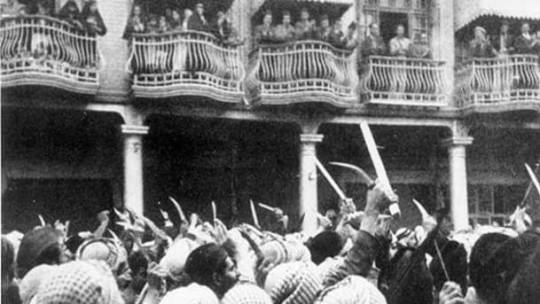
The Farhud pogrom in Baghdad of 1941, people in Baghdad carrying swords.

Mass grave of victims of the Farhud, 1941.
Farhud memories: Baghdad's 1941 slaughter of the Jews
Acre, now 79 and living in Montreal, climbed a palm tree in the courtyard when the violence began. He still remembers the cry "Cutal al yehud" which translates as "slaughter the Jews".
From the tree he could see the landlord sitting in front of the house. "When the mob came he talked to them. He told them that we are orphans who took refuge in his house and they cannot touch us. If they want us they have to kill him. So lucky for us, the mob moved away, moved to other houses," he remembers.
The men then crossed the street and screams began to emanate from the house of his mother's best friend.
"Later lots of men came outside and set the house on fire. And the men were shouting like from joy, in jubilation holding up something that looked like a slab of meat in their hands.
"Then I found out, it was a woman's breast they were carrying - they cut her breast off and tortured her before they killed her, my mother's best friend, Sabicha."
“The Farhud” As My Father Told It to Me / Oshra Shaib Lerer
I was four years old when the Six Day War broke out, the war that brought with it the hubris, the arrogance, and the “shufuni,” or “everyone, look at me.”
For my father, the war brought something else. It brought a bounty of books in Arabic, which were now available for purchase in Gaza. The house filled with books in Arabic, which we children, in shame, shoved into deep storage, far away from the eyes of guests and friends.
The books were the path back to the language, which he so loved: Arabic. With the books came the stories of the city that just can’t be forgotten: Baghdad. The markets where he sold his merchandise. Skipping ahead a couple grades at the Muslim and Jewish school. The rooftops they climbed to sleep on sweltering nights. The alleyways and the bridge. The communist underground. And many more.
My father longed for the words and, to borrow a wonderful expression coined by Dudi Busi, rolled them on his tongue like he was asking to touch them and not just one more time – to touch them through the Arabic radio stations, the television programs, the prayers from the Qur’an during Ramadan and through the books.
Mostly, he came back to those three days of slaughter, robbery and looting that happened to the Jews of Iraq. Three days that are the microcosm of the complexity of being a Jew in Iraq on Shavuot of 1941. This week he recounted the story to his granddaughter:
In 1941, about a month ahead of the Shavuot holiday, the rule of the British Mandate in Iraq was toppled by al-Gaylani. On Shavuot eve, rumors spread that the Iraqi army was defeated and that English had returned to rule Iraq. The Jews celebrated the holiday and the victory in the streets and in the synagogues. Baghdad was in a state of anarchy as the English had yet take power and Nazi rule was crumbling. The poor people living on the other side of the Tigris took advantage of the situation and crossed the river and to rob, pillage and murder Jews. As news of the slaughter reached out neighborhood, we began to barricade our homes and prepare for self-defense: hot oil, stones, reinforcing the gates to the homes and more. Some of the Arabs, which I call “Righteous Among the Nations” protected Jews while risking their own lives.
My father returned that day from the market, told us about the terrible killing happening throughout the city in the Jewish neighborhoods, and said we must defend ourselves. We, who lived in the heart of the Muslim Arab neighborhood, climbed up on the roof and cried out for help. The aid came from our Muslim neighbor. With his encouragement, we jumped from our roof to his. As this was happening, the neighbor threatened his mother with a gun that if she will turn us in instead of helping, he will shoot her. We stayed at the neighbor’s house for two days of horror and he protected us and provided us with water and food until the rage faded away. Our house was pillaged but we were saved.
This is my father who called himself an “Arab Jew” before it became a political statement, out of love and appreciation for the Arab culture in which he grew up. It was a love he tried to pass on to us, his children. To my father, Avner Izak Shaib, who taught me pride and wisdom, I dedicated the song “No, It Is Not I Who Would Cry” by Mohamad Abdel Wahab.
(Sources: Wikipedia, BBC, +972mag, Holocaust Memorial Museum)
52 notes
·
View notes
Text
The King of Arabian Music: Abdel Halim Hafez
Arguably one of the best and in many eyes the best singer in Arabian music history:
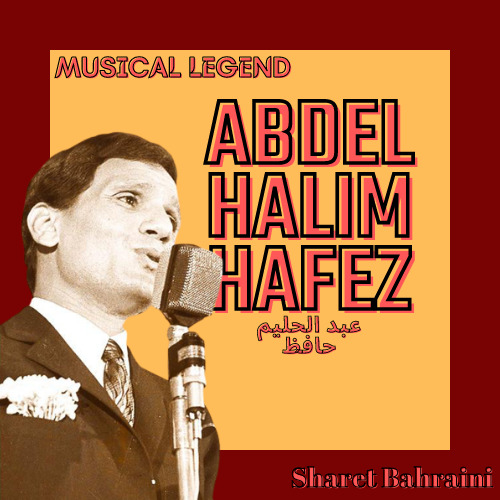
ORIGINS:
Born on June 2, 1929, Abdel Halim Ali Shabanah was considered bad luck as his mother died three days after his birth due to labor complications and his father died five years later. He lived in an orphanage for some years and was then raised by his impoverished aunt and uncle.
His musical ability was noticed by his brother Ismail who was his teacher during primary school. At the age of 14 he joined the Institute of Arabic Music and the Higher Institute for Theatre Music and in 1948 graduated from the Academy of Arabic Music but sources claim he dropped out of the Institute for Theater Music.
START OF JOURNEY:
At the start of his journey, Abdel Halim was a teacher and then an oboe player for a radio program but when he decided to take a vocal aim, he started singing at clubs in Cairo and became quite popular for singing Mohamed Abdel-Wahab’s songs. One day due to Karem Mahmoud’s absence from a live radio performance, Abdel Halim was brought in as a last-minute replacement.
When Abdel Wahab Hafez heard him, the supervisor of musical programming for the Egyptian national radio he signed him, and as a sign of his appreciation for him, Abdel Halim added Hafez to his stage name.
CAREER:
He was given the nickname ( العندليب الأسمر), meaning The Dark-Skinned Nightingale.
At the start of his career, he was somewhat rejected for his new style of singing, he tried to incorporate new western instruments such as the Moog synthesizer and was one of Egypt's first romantic singers but he grew in popularity and his artistry shined through.
He worked with Mohamed Abdel Wahab, and according to some sources he was somewhat of a mentor to Abdel Halim, it is said that Abdel Halim took his place after Mohamed switched from singing to composition. Together they made some classic songs such as Ahwak, Nebtedi Minen el Hekay, Fatet Ganbena.
He rarely ever released a studio album with most recordings of his songs coming straight from a live performance, you can even hear the audience cheering in some recordings, he considered himself a live singer and performed in many Arab countries, and seldom would he not be performing at a sold-out show.
Abdel Halim was also a conductor, actor, film producer, director, and businessman, he acted in 16 films, the first being Song of Truth (1955) and the last being Abi foq al-Shagara (1969) and according to some sources he was in the first color motion picture movie in Egypt called Dalilah. He was also one of the founders of “Sawt al-Fann” a production company, with Mohamed Abdul Wahab and Waheed Fareed.
PASSING:
Abdel Halim died of liver failure due to Schistosoma, a parasite he had been suffering from since he was 11, it is said that almost every spring, (which is the time he would usually perform) he would have a health crisis. Some sources claim on the last days of his life his mental health has been on the decline and he was receiving therapy. he died on March 30, 1977, at the age of 47 in King's College Hospital, London, it is said that he was still recording during his sickness and he still had many dreams and goals that he sadly didn’t get to achieve. His funeral was attended by millions of people, at least 4 people committed suicide during his funeral march. He was buried in Al Bassatine Cemetery in Cairo. He was a good man and a great musician May he rests in peace (الله يرحمه).
LEGACY:
Despite somewhat of a short career, he created more than 300 songs and 16 films, Abdel Halim was a monumental artist influencing many. His patriotic songs pushed people to fight for their countries. He was called “Son of the Nile”, “Son of the revolution” and even “King of Music.” He has sold more than 80 million records and opened a hospital in Egypt in 1969.
His song Khosara was also sampled by Jay-Z in Big Pimpin. A remix more centered around the instrumental was featured in Moon Knight.
There were also multiple occasions of people trying to relive his amazing performance through a hologram.
If you are looking to get into his music I would recommend "Ahwak.
1 note
·
View note
Text
Wahabism in Islam 2

SIMILARITIES BETWEEN WAHHABISM AND SANGH
Click here to read the Previous Part of this Article
Apparently comparing the Sangh to Wahhabism may upset you as it is a comparison of a small model to a larger model but it is at the level of ideology, not on performance. If you assess it minutely, then you will understand, but for that, you will have to come out of your prejudices.
You go straight to the point that ‘Wahhabism is equal to terrorism’ but Wahhabism is an ideology, and terrorists may be of this ideology but they themselves are not the whole ideology. You can understand this with an example in a simple way.
Saudi Arabia promotes Wahhabism all over the world. The Crown Prince of that Arabia is Muhammad bin Salman and when he comes to India, the hero of your firebrand Hindutva welcomes him in a grand style. Do you even think for a second that how our Hindu icon is embracing him?

Obviously, you must have seen it as its outer face, that the heads of the two nations are meeting and talking… while as the inner face the two fundamentalist advocates of uniformity were meeting with each other. This is the similarity.
How Homo sapiens won the battle of survival?
For the spread of ideology, this outer-inner face theory is necessary. When Islam was spread, the outer face was put forward that was accepting each integrating culture with a warm heart. It was the stage of up-gradation and when it was completed, then they started a campaign to go back to the era of fourteen hundred years back by resetting the system.
The Sangh is still going through the initial phase of this up-gradation. It participates in riots in 1984 against Sikhs as well as against Muslims in 2000, but it also has wings like ‘Rashtriya Muslim Manch’ and ‘Rashtriya Sikh Sangat’. It will make Modi Prime minister and Yogi a chief minister those are considered as the hero of right-wing people on the basis of Muslim hatred and will also claim that Muslims are also our brothers.
Right now it is flexible in the outer face, but when it will get hold of all the states, all constitutional, non-constitutional institutions along with the centre, then perhaps there will be no freedom to insult Rama in the south, nor to deny the deities of north India, nor the tribal groups will be allowed to worship their gods. Tribes, Lingayat, Periyars, Ambedkarwadi will be their special target (there may be special provision for heretics) and then they will also give two options to either become like us or become ‘Gauri Lankesh’. They might give two options to the heretics or limit them to the only option in the name of centuries-old revenge… that is death.
Where did religion come from and how logical from the point of view of science?

UP-GRADATION AND RESETTING
The only difference between the two ideologies is that the up-gradation of Islam has been completed and it is in the reset mode in the form of Wahhabism, while the up-gradation of the Sangh has just begun.
You talk about the similarity between the Sangh and Wahhabism and any Hindu who has a soft corner for the Sangh will immediately argue against it with multiple examples that the Sangh is a cultural organization that accepts all the beliefs and gives freedom to follow what you believe. He will immediately deny the person or gang who has taken any violent action to be a part of it. If you will connect Wahhabism with terrorism, the person who has a soft corner for Wahhabism will immediately explain the same Quranic verses and Hadiths from a liberal and humanitarian perspective on which these terrorist organizations form their foundation… and he will also reject them from Islam immediately.
These two are sailing in the same boat, who deny the inner face of these ideologies in the fascination of their outer face, simply because they have a soft corner for them. However, unlike Muslims, a large section of this right-wing ideology also openly accepts this inner face and justifies it by calling it a reaction to action.
Can religion and logic walk together
But the victims of the reaction are not actually responsible for that action, rather they are the initiators of the reaction of that reaction in some way. However, this chain of action and reaction drag the society towards that direction where no one’s life remains safe. Many Islamic countries are living examples of this and if we do not show a comprehensive understanding in this regard, then we will be the next in this sequence.
Now let us see how the current era of terrorism got mixed with this global ideology that gives new dimensions to bigotry. Because after the initial phase, it has now included political interest and greed for power once again… You cannot give Al-Shabaab of East Africa, Boko Haram of West Africa or Jamaat-e-Islami of Bangladesh a different identity than this.
Apart from these, organisations like Taliban, Al Qaeda, Sipah-e Sahaba, Jamaat-ud-Dawa, Al Khidmat Foundation, Jaish-e-Muhammad, Lashkar-e-Taiba, IS are also the bearers of the same ideology those are constantly playing bloody games. It cannot be denied that in its background you will also find those capitalist powers those not only encourage every such possible struggle with Muslims at its one end but also provide money and weapons to fulfil their political or economic interests. The root of the alliance between America and Al Saud is that this radical Islamic ideology serves many of its political and economic interests.
what possibilities are there in the universe outside our planet

A youth gets caught in the trap for two reasons. Either he himself has been a victim of such atrocities those are found in abundance in Afghanistan, Palestine, Iraq, Syria or Kashmir. As an Indian, you may find it difficult to digest about Kashmir, but this is the truth… or he is a person who struggles with poverty, unemployment, starvation and gets a salary to fight like this.
When both such people come in contact with them, they are brainwashed saying that their fight is ‘jihad’ in which even death is martyrdom from the perspective of Islam. You will enter into Jannat after death and killing the kafirs is not a crime… The verses that the alims here explain in other ways are applied to those youths in their own style and from a pure Islamic point of view, only those interpretations are right. They get the desired results as the person becomes ready to fire indiscriminately on the streets, becomes a suicide bomber, agrees to run a truck over the crowd.
Obviously, there can be many reasons for terrorism, but where the fight of other communities against oppressiveness or exploitation is never given a religious identity, the fight of Muslims, irrespective of the cause, is always connected with the religion because it has a global appeal… because it has the scope of getting support and cooperation of like-minded immediately.
This way or that… however, it is a fight to colour the whole world in the Wahhabi ideology. It acknowledges oneness and what is outside it is worthless. This ideology is a direct attack on the diverse inclusive culture that we have been accustomed to see. The beauty of a garden is only when there are flowers of every variety in it… If there is only one variety then it no longer remains a garden, it becomes like a farm. Wahhabism is an ideology that transforms the garden of Islam into a farm.
If God is there then how can it be from the point of view of science

Stories related to Indian society and culture that will shake you and make you think
HOW CAN YOU FIGHT BIGOTRY
Now the question is how to fight it… If we talk only in the context of India then the right-wing ideology of reaction to action to fight this is more problem creating. In Godhra, if some of the fanatic Muslims will burn the rail coach, the angry Hindus of Gujarat will kill more than two thousand Muslims in response who were not guilty of the incident. Then, the kith and kin of the victims of this massacre, will take up weapons and form an ‘Indian Mujahideen’. Outside the country, the merchants of death are ready with money and weapons to grab such angry youth.
How to write a book in Microsoft word
And then they will explode bombs… You will react again, and this series will continue… In this way, a state of anarchy will remain. In such a situation, hardcore Hindus compare it with Rohingya. The Rohingya belong to Myanmar where no one is interested but India is a superpower and many countries are interested in it… If there will be opportunities to destabilize it, then big countries will be interested in it. If the situation worsens here, it will become difficult to handle. Violence in the name of reaction cannot be a solution to fight this ideology.
For this, not only governmental but also social efforts will have to be made. Some steps should be initiated by the government and some by the people and institutions that have knowledge of all this… The goal should be freedom from the bigotry that pushes a person to take up arms in some weak moments. There is definitely a big section of hardcore Indian Muslims, but they are still not inclined towards this so-called ‘jihad’ at all… and efforts should be made to prevent this happen in future.
Even mentioning ‘jihad’ should be banned, no matter how lenient its interpretation as ‘jihad al-nafs’ is. Religious institutions should be monitored by the government. Madrasas should be made the centre of modern education and religious education should be introduced only when the child becomes a little mature. The influence of religious teachings from childhood pushes the child closer to Saudi Arabia than to India.
At the social level, the beauty of diversity over uniformity should be explained in majlis, meetings, events, etc. The importance and acceptance of inclusive culture should be emphasised… and this is not a difficult task. Education alone is not enough for Muslim youth but they should also be encouraged to develop an understanding of how to coordinate with other cultures and that they need to be tolerant to such an extent that nothing is beyond criticism. Neither God nor his prophets and nor religious books.
How to design an ebook and how and where to publish

Move away from the model of Ibn Taymiyya, Abd al Wahhab, Maulana Maududi and insist on accepting all the firqas found in India in the name of Islam along with their culture, customs, traditions, etc. as part of Islam… instead of declaring them kafir, mushrik, munafiq, Khariji, Rafzi, etc., then this fanaticism will be reduced itself. People need to understand that they are Indians, not Saudi Arabian and they need to look like Indians and not Arabic.
And this measure is only effective in India because the Muslims here are different from the Muslims of the rest of the world in many ways… It is difficult to suggest any remedy for the rest of the world. Either they will fight with each other like Pakistan, Afghanistan, or will be destroyed like Syria, Iraq by falling prey to the selfishness of America, Russia, Britain, Israel etc. because… it is the real Islam.
Know about human development, the origin of religions, universe and possibilities of God

0 notes
Text
Mobile packages

The Internet (or internet) is the worldwide arrangement of interconnected PC organizes that utilizes the Internet convention suite (TCP/IP) to convey among systems and gadgets. It is a system of systems that comprises of private, open, scholarly, business, and government systems of neighborhood to worldwide degree, connected by a wide cluster of electronic, remote, and optical systems administration advances. The Internet conveys a tremendous scope of data assets and administrations, for example, the between connected hypertext reports and utilizations of the World Wide Web (WWW), electronic mail, communication, and document sharing. Mobile packages
The starting points of the Internet go back to the advancement of parcel exchanging and research appointed by the United States Department of Defense during the 1960s to empower time-sharing of computers. The essential antecedent system, the ARPANET, at first filled in as a spine for interconnection of provincial scholastic and military systems during the 1970s.
The financing of the National Science Foundation Network as another spine during the 1980s, just as private subsidizing for other business expansions, prompted overall support in the improvement of new systems administration advances, and the merger of numerous networks. The connecting of business systems and ventures by the mid 1990s denoted the start of the change to the cutting edge Internet, and created a continued exponential development as ages of institutional, individual, and portable PCs were associated with the system. In spite of the fact that the Internet was broadly utilized by the scholarly community during the 1980s, commercialization joined its administrations and advancements into practically every part of present day life.
Most conventional correspondence media, including communication, radio, TV, paper mail and papers are reshaped, reclassified, or even avoided by the Internet, bringing forth new administrations, for example, email, Internet communication, Internet TV, online music, advanced papers, and video real time sites. Paper, book, and other print distributing are adjusting to site innovation, or are reshaped into blogging, web channels and online news aggregators. The Internet has empowered and quickened new types of individual cooperations through texting, Internet discussions, and long range informal communication. Internet shopping has become exponentially both for significant retailers and independent companies and business people, as it empowers firms to broaden their "blocks and concrete" nearness to serve a bigger market or even sell merchandise and enterprises totally on the web. Business-to-business and monetary administrations on the Internet influence flexibly chains across whole ventures.
The Internet has no single incorporated administration in either mechanical execution or arrangements for access and use; every constituent system sets its own policies. The overextending meanings of the two chief name spaces in the Internet, the Internet Protocol address (IP address) space and the Domain Name System (DNS), are coordinated by a maintainer association, the Internet Corporation for Assigned Names and Numbers (ICANN). The specialized supporting and normalization of the center conventions is a movement of the Internet Engineering Task Force (IETF), a non-benefit association of approximately subsidiary worldwide members that anybody may connect with by contributing specialized expertise. In November 2006, the Internet was remembered for USA Today's rundown of New Seven Wonders.
Telenor Pakistan (Pvt.) Limited (Urdu: ٹیلی نار پاکستان) is the second biggest cell and computerized administrations supplier in Pakistan possessed by Telenor Group, which is a universal supplier of voice, information, substance and versatile correspondence administrations in 8 business sectors worldwide in Scandinavia and Asia. Telenor began as an open organization in 1855. Irfan Wahab Khan is the current CEO of Telenor Pakistan since August 2016.
At present, Telenor Pakistan has an absolute endorser base of 45 million with 27% cell piece of the pie in Pakistan and in excess of 1,300 representatives. Since its dispatch in 2005, the organization has made a venture of more than $3.5 billion.
Telenor gained a permit for giving GSM administrations in Pakistan in April 2004, and propelled its administrations industrially in Karachi, Islamabad, and Rawalpindi on 15 March 2005; it extended its administrations to Lahore, Faisalabad and Hyderabad on 23 March 2005. Telenor Pakistan's corporate central command are in Islamabad, with territorial workplaces in Peshawar, Lahore, Faisalabad, Multan, Hyderabad, Quetta and Karachi.
The official opening of Telenor Pakistan was held in Islamabad in which previous leader of Pakistan General Pervez Musharraf was the visitor of honor and was gone to by Telenor designation headed by president and CEO of Telenor Group Jon Fredrik Baksaas alongside then CEO of Telenor Pakistan Tore Johnsen. The main call at the initiation was made by previous President Pervez Musharraf to the leader of Norway, Jens Stoltenberg, who was visiting Australia at that point. Telenor Pakistan's new headquarter named '345' was introduced in Islamabad on 1 November 2017 by the then leader of Pakistan Shahid Khaqan Abbasi. The new headquarter was worked at an expense of $80 million.
Telenor Pakistan covers over 80% of Pakistan's populace in urban and provincial zones with a system of more than 11,000 cell locales of which 80% are 3G and 70% are 4G empowered. The organization has been granted various ventures under Universal Service Fund (USF) of which the one as of now in progress in the Broadband for Sustainable Development (BSD) program under which in excess of 100 new cell locales will be set up to get network to 1.7 million Dera Ismail Khan and Mohmand Agency. before, Telenor dealt with USF Projects for cell site establishment in Bahawalpur-Cholistan area in 2009 and arrangement of 3G benefits in Kohistan region in 2017.
0 notes